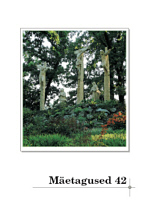Hiied Eesti pühapaikade uurimisloos
Hiis Sites in the Research History of Estonian Sacred Places
Author(s): Tõnno JonuksSubject(s): Cultural history
Published by: Eesti Kirjandusmuuseum
Keywords: hiis; national identity; sacred natural places; research history
Summary/Abstract: Sacred natural places, among which hiis sites form the best known and the most thoroughly investigated part, have started to attract multifarious scientific interest only recently. Although pagan sanctuaries have been the object of research for the clergy, politicians, and historians already since the 18th century, more general and analytical studies are still lacking. In this article I will try to offer a historiographical overview of sacred natural sites in Estonia and point out some aspects which play an important role in the studies, even though the historical background of the topic has often been neglected. The earliest and probably the most famous description of holy places date from the beginning of the 13th century when the chronicler Henry of Livonia described two places with a sacred forest in North Estonia. Throughout medieval and modern times, holy places were mentioned only in connection with the descriptions of the local people who worshipped idols. Such texts mainly mention the holy sites and the fact that offerings were made there reflect most importantly the veneration of trees, but also stones, and other objects. The characteristic motif in most of these texts, however, is the proscription against damaging the holy place. This is also characteristic of the 19th- to 20th-century folklore in general. At the end of the 18th century, together with the Enlightenment movement, a new period began in the research history, when holy places became the objects of study rather than being merely an element of pagan customs. A Romantic concept of hiis was formed in the 18th century. Next to the 18th-century Baltic-German researchers of the Enlightenment mentality, the emerging Estonian and Finnish national intelligentsia started to pay attention to the sacred places of the present and the past. For the first time, the word hiis and its etymology became an important issue and several different meanings were proposed: starting from the connection of the Ancient Mediterranean culture to the concept of hiis as a mythological creature or a giant (Est. hiid). From the mid-19th century onwards, organised collecting of folklore was started in Estonia and reached its peak by the end of the century. On the basis of the material collected, the first serious studies on holy places were made. Until the first half of the 20th century holy places were interpreted mostly as sacrificial places - an interpretation which obviously derives from contemporary folklore. Hiis was explored together with other sacred sites mentioned in folklore (sacrificial stones, yards, etc.) and the diversity of holy places was particularly stressed. A characteristic element of the period was a clear opposition of hiis/folk religion and church/Christianity, in which hiis was defined as an idealised natural sanctuary which “is not confined by stone walls”.
Journal: Mäetagused. Hüperajakiri
- Issue Year: 2009
- Issue No: 42
- Page Range: 33-54
- Page Count: 22
- Language: Estonian

